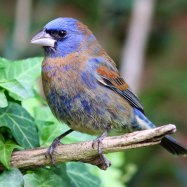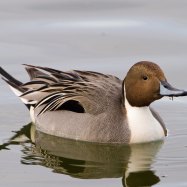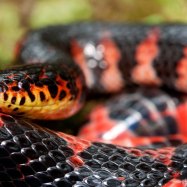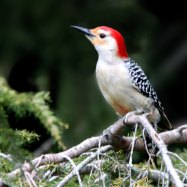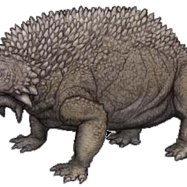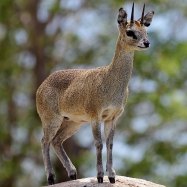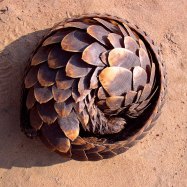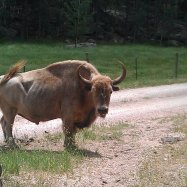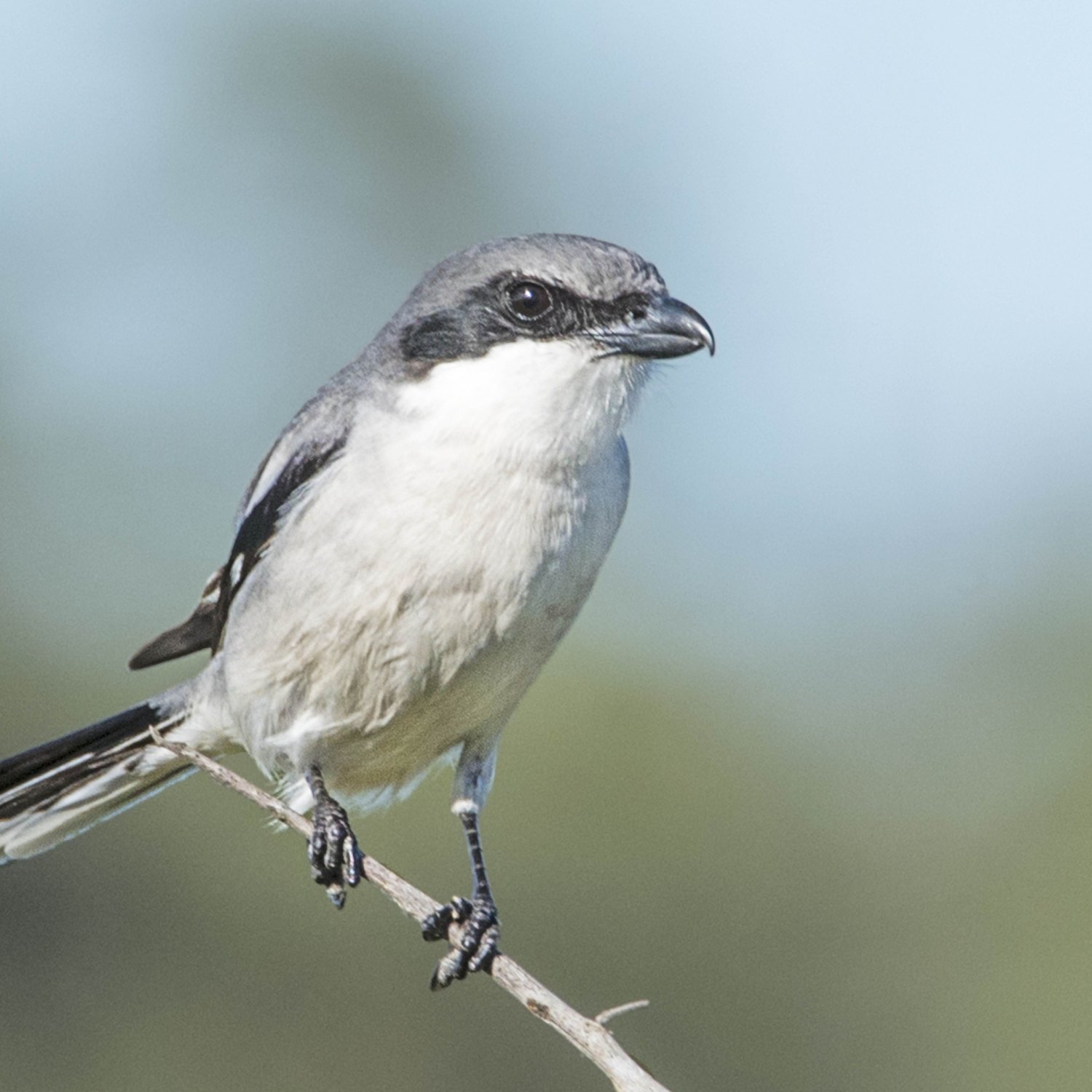
Loggerhead Shrike
8 to 10 inches
The Loggerhead Shrike, common throughout the US, is a small and compact bird with a length of 8 to 10 inches. Despite its cute appearance, it is a fierce predator with a hooked beak and sharp talons. Belonging to the Laniidae family, they are known for impaling their prey on thorns, earning them the nickname butcher bird. #Animals #LoggerheadShrike #Predator
Animal Details Summary:
Common Name: Loggerhead Shrike
Kingdom: Animalia
Habitat: Open fields, grasslands, shrublands, and agricultural areas
The Majestic Loggerhead Shrike: A Small but Mighty Predator of North America
In the vast wilderness of North America, there is a creature that may seem small and unremarkable at first glance, but upon closer inspection, reveals itself to be a fascinating and formidable predator. Meet the loggerhead shrike, also known by its scientific name Lanius ludovicianus.Despite its diminutive size of only 8 to 10 inches, the loggerhead shrike has earned its reputation as a powerful hunter. Its common name, "loggerhead," refers to the large and robust head of the bird, which resembles that of a small hawk or falcon Loggerhead Shrike. This strong and compact body shape is a key feature that allows the loggerhead shrike to excel in its hunting techniques.
The Natural Habitat of the Loggerhead Shrike
You can find loggerhead shrikes in various habitats throughout North America, including open fields, grasslands, shrublands, and even agricultural areas. These birds prefer to live in open areas with low vegetation, which allows them to easily spot their prey. They can also be found in scrubby areas, such as desert scrub, chaparral, and sagebrush.Loggerhead shrikes are highly adaptable creatures and can be found in a wide range of environments, from the southern reaches of Canada to the northern parts of Mexico. They have also been spotted in the Caribbean islands, but their primary range is in the United States.
Carnivorous Feeding Style: Ferocious yet Resourceful
As mentioned earlier, the loggerhead shrike is a predator, and a carnivorous one at that. Unlike other birds, which mainly feed on insects and worms, these shrikes have a more substantial diet. They have a very strong, hooked beak that allows them to capture and kill larger prey such as lizards, small mammals, and even other birds Lyrebird.The shrikes' killing strategy is both fascinating and brutal. They are known for impaling their prey on sharp thorns, barbed wire fences, and other sharp objects. This behavior not only immobilizes the prey but also allows the shrike to easily tear it apart and eat it. They also have a unique way of storing their food on thorns and branches, creating a "larder" of sorts for future meals.
The reason behind this impaling behavior is not entirely understood, but scientists believe it may be a way to store food during times of scarcity, or to attract a mate by displaying hunting prowess. Nonetheless, the loggerhead shrike's resourcefulness in finding and storing food is impressive, especially given their small size and delicate appearance.
From Egg to Fledgling: The Life Cycle of a Loggerhead Shrike
Loggerhead shrikes usually mate for life, and both the male and female take part in building the nest using materials such as twigs, grass, and bark. They generally have one brood per year, with each clutch containing around 5-7 eggs.The eggs are incubated by both the male and female shrike for about 18-21 days. Once hatched, the parents work together in raising their young, which can take up to 28 days. During this time, the chicks are fed mostly insects, but as they grow, the parents start introducing them to meat.
Once the fledglings are old enough, they leave the nest and start hunting on their own, but they may still rely on their parents for a few weeks until they become completely independent. The juvenile shrikes have similar features to the adults, but they lack the distinctive black mask that gives the adults their fierce look.
The Unique Anatomy and Appearance of the Loggerhead Shrike
The loggerhead shrike's body structure is designed for hunting, with a strong, hooked beak for tearing meat, sharp talons for gripping onto prey, and a thick neck and chest muscles for powerful movements.This bird has a grayish-brown coloration on its upper body, with white underparts. It also has a distinctive black mask that covers its eyes and extends to its beak. This feature gives the shrike a fierce and intimidating appearance, making it easier for them to hide from predators and blend in with their surroundings.
Loggerhead shrikes also have a wide wingspan, which helps them navigate and hunt in open areas efficiently. They have a swift and agile flight, often making quick turns and dives in pursuit of their prey.
A Bird with a Captivating Song
Apart from its exceptional hunting abilities and unique physical features, the loggerhead shrike is also known for its beautiful and diverse songs. The males are usually the ones to sing, and they use their songs to mark their territory and attract potential mates.The songs of loggerhead shrikes can range from harsh and raspy to melodious and flute-like, and they often incorporate a series of trills, whistles, and chatters. This bird's song is so distinctive that it has received the nickname "mockingbird of the fields."
Conservation Status and Threats to the Shrikes' Population
Although the loggerhead shrike is not considered to be a threatened species at the moment, their population has been declining in recent years. The main threats to these birds include habitat loss due to human activities such as urbanization and industrialization, as well as the use of pesticides, which can poison their prey and affect the shrikes' health.Additionally, the decline of small mammal populations, which are a primary food source for the shrikes, has also greatly affected these birds. Because of these factors, conservation efforts have been put in place to protect and preserve the loggerhead shrike's population and its natural habitat.
In Conclusion
In a world full of fierce and remarkable predators, the loggerhead shrike may not stand out at first glance. But dig deeper, and you'll discover a fascinating and resilient creature that has adapted to thrive in a changing environment.From its impressive hunting techniques to its unique anatomy and captivating songs, the loggerhead shrike is a true marvel of nature. So the next time you come across this unassuming bird in the wild, take a moment to appreciate its beauty and appreciate its extraordinary abilities as a mighty predator of North America.

Loggerhead Shrike
Animal Details Loggerhead Shrike - Scientific Name: Lanius ludovicianus
- Category: Animals L
- Scientific Name: Lanius ludovicianus
- Common Name: Loggerhead Shrike
- Kingdom: Animalia
- Phylum: Chordata
- Class: Aves
- Order: Passeriformes
- Family: Laniidae
- Habitat: Open fields, grasslands, shrublands, and agricultural areas
- Feeding Method: Carnivorous
- Geographical Distribution: North America
- Country of Origin: United States
- Location: Throughout the United States
- Animal Coloration: Grayish-brown with white underparts
- Body Shape: Small, compact
- Length: 8 to 10 inches
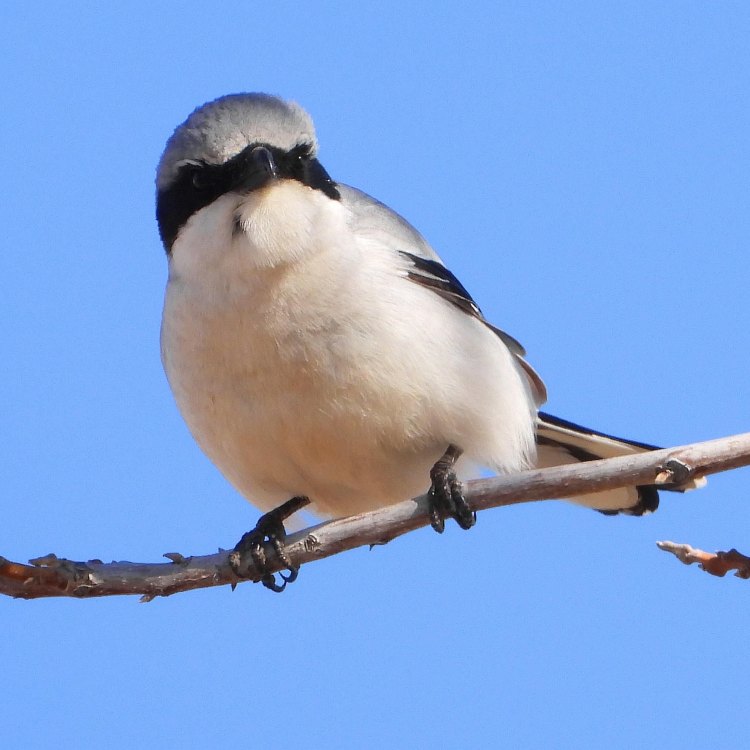
Loggerhead Shrike
- Adult Size: Small
- Average Lifespan: 2 to 3 years
- Reproduction: Monogamous
- Reproductive Behavior: Builds nests in shrubs or trees
- Sound or Call: Harsh, raspy notes and mimicry of other bird songs
- Migration Pattern: Partial migrant
- Social Groups: Solitary or in small family groups
- Behavior: Aggressive hunter and impales prey on thorns or barbed wire
- Threats: Habitat loss, pesticide use, and climate change
- Conservation Status: Least Concern
- Impact on Ecosystem: Helps control populations of insects and small vertebrates
- Human Use: Not commonly used by humans
- Distinctive Features: Black mask across the eyes and hooked bill
- Interesting Facts: Due to its hunting behavior, it is sometimes called the 'butcher bird'
- Predator: Large raptors and other birds of prey
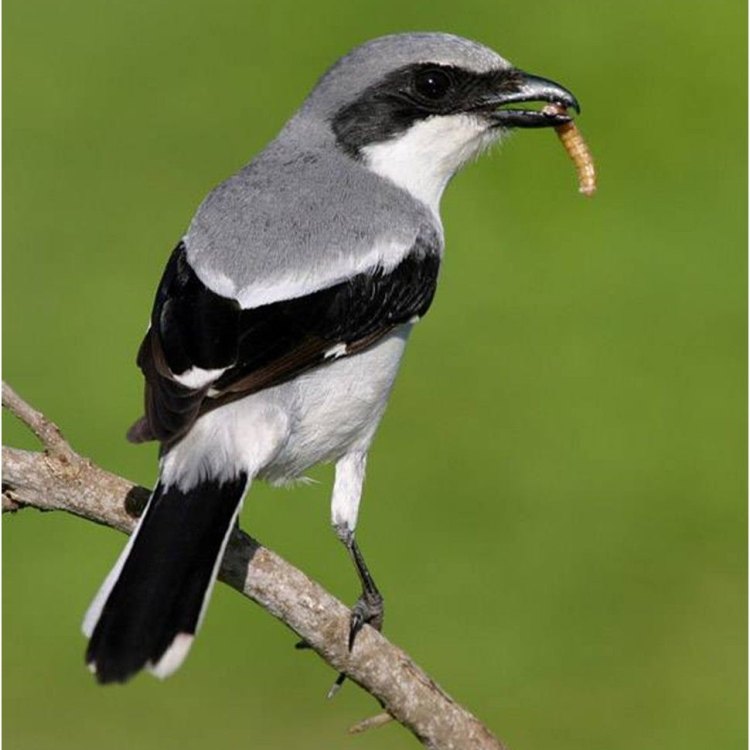
Lanius ludovicianus
The Fascinating Loggerhead Shrike: A Small Bird with Surprising Features
There is something charming and intriguing about small creatures. They often have unique behaviors and distinctive features that capture our attention. One such bird that falls into this category is the Loggerhead Shrike.Also known as the Butcher Bird, the Loggerhead Shrike is a small but fierce predator that has captured the curiosity of bird enthusiasts for years PeaceOfAnimals.Com. From its behavior to its distinctive physical traits, this bird has some truly fascinating features that make it stand out in the avian world.
In this article, we will dive into the world of the Loggerhead Shrike, exploring its size, lifespan, behavior, and other interesting facts that make it a truly remarkable bird.
The Size and Lifespan of the Loggerhead Shrike
The Loggerhead Shrike may be small in size, but it makes up for it with its impressive hunting skills. This bird measures about 9 inches in length and weighs around 2 ounces, making it a small but mighty predator.As for its lifespan, the Loggerhead Shrike has an average lifespan of 2 to 3 years in the wild. However, some individuals have been known to live up to 5 years, while those in captivity can live up to 10 years.
Reproduction and Nesting Behavior
Like many birds, the Loggerhead Shrike is monogamous, meaning it mates with only one partner for the duration of its breeding season. This bird typically breeds between April and July, with the female laying around 5 to 6 eggs in a single clutch.What makes the breeding behavior of the Loggerhead Shrike unique is its choice of nesting sites Luna Moth. Unlike other birds that build their nests in trees or on the ground, the Loggerhead Shrike prefers to build its nest in shrubs or trees. These nests are typically made of twigs, grass, and other plant materials, and are often hidden from view.
The Sound of the Loggerhead Shrike
One of the most distinct features of the Loggerhead Shrike is its call. This bird is known for its harsh, raspy notes that it uses to communicate with other birds. In addition to its own call, the Loggerhead Shrike is also known for its ability to mimic the songs of other birds, further adding to its unique sound repertoire.Migration Pattern and Social Behavior
The Loggerhead Shrike is considered a partial migrant, meaning that while some individuals migrate during the winter months, others may stay in their breeding grounds year-round. This migration typically occurs from northern areas down to more southern regions.In terms of its social behavior, the Loggerhead Shrike is mostly solitary but may form small family groups during the breeding season. These family groups consist of the mated pair and their offspring.
Hunting Behavior and Threats
Perhaps one of the most fascinating aspects of the Loggerhead Shrike is its aggressive hunting behavior. This bird is a skilled hunter, using its hooked bill to catch and impale its prey. It typically hunts insects, small birds, and small vertebrates such as lizards and mice.After catching its prey, the Loggerhead Shrike impales it on thorns or barbed wire, creating a "larder" or storage area for when food is scarce. This behavior is where the bird gets its nickname, the "butcher bird."
Unfortunately, the Loggerhead Shrike's population is declining due to various threats, including habitat loss, pesticide use, and climate change. These factors are causing a decrease in their prey population and the destruction of their nesting sites, making it more challenging for them to survive.
Conservation Status and Impact on Ecosystem
Despite the threats it faces, the Loggerhead Shrike's conservation status is currently listed as "Least Concern" by the International Union for Conservation of Nature (IUCN). However, this bird is protected under the U.S Migratory Bird Act, making it illegal to harm or disturb them.The Loggerhead Shrike plays a crucial role in its ecosystem, as it helps control the population of insects and small vertebrates. This bird's hunting behavior helps maintain balance in the ecosystem, preventing an overpopulation of prey species.
The Loggerhead Shrike in Human Culture
While the Loggerhead Shrike is not commonly used by humans, it has made its way into human culture through various references. For example, it has been featured in literature, such as the novel "To Kill a Mockingbird" by Harper Lee, where it is referenced as a "mockingbird."Additionally, the Loggerhead Shrike's name has been adopted by a popular indie-rock band called "The Shins," who released the single "Phantom Limb," which references the bird's behavior of impaling its prey.
Distinctive Features and Interesting Facts
One cannot talk about the Loggerhead Shrike without mentioning its distinctive features. This bird has a black mask across its eyes and a hooked bill, which it uses for hunting and impaling its prey.In addition to its distinctive features, the Loggerhead Shrike has some interesting facts that make it even more unique. For example, did you know that this bird has been observed using its wings to spread and sunbathe? This behavior is thought to help with mites and parasite control.
Another interesting fact is that the Loggerhead Shrike has been known to attack and chase off birds much larger than itself. This behavior is seen in both male and female shrikes and is referred to as "mobbing."
Predators of the Loggerhead Shrike
Like all creatures, the Loggerhead Shrike has its own predators to contend with. Large raptors and other birds of prey, such as hawks and falcons, are the primary predators of the Loggerhead Shrike. These larger birds see the shrike as competition for food and often attack and kill them.In Conclusion
The Loggerhead Shrike is a remarkable bird that may be small in size, but it more than makes up for it with its unique features and behaviors. From its aggressive hunting tactics to its monogamous breeding behavior and impressive mimicking abilities, this bird has captured the attention of nature enthusiasts worldwide.However, the Loggerhead Shrike's population is facing threats, and it is crucial to take steps to protect and preserve this remarkable species. By learning about and appreciating the Loggerhead Shrike, we can better understand the impact of human actions on the environment and take steps to mitigate them. After all, as with all creatures big and small, every living being plays a vital role in maintaining balance in our ecosystem.
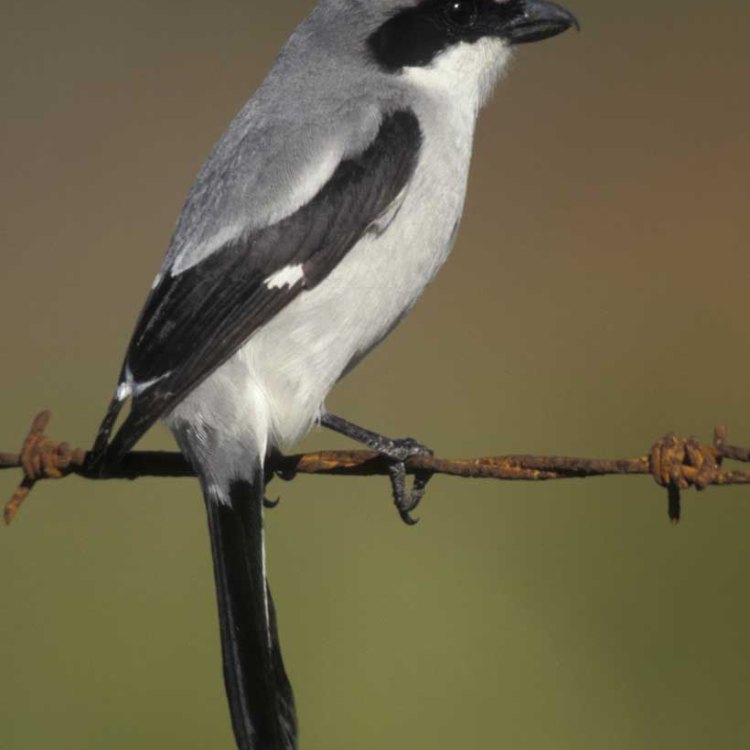
The Majestic Loggerhead Shrike: A Small but Mighty Predator of North America
Disclaimer: The content provided is for informational purposes only. We cannot guarantee the accuracy of the information on this page 100%. All information provided here may change without prior notice.

